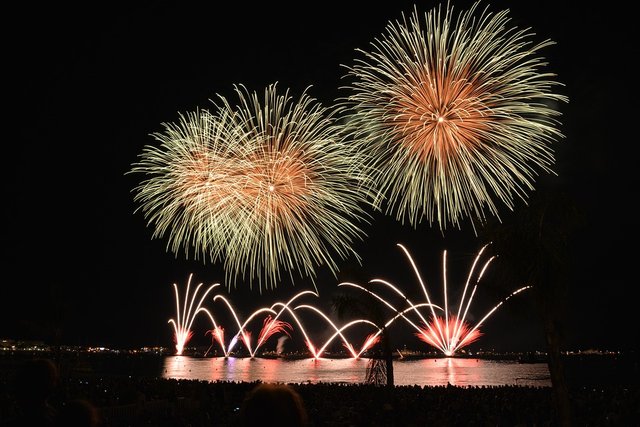Burning salts - History and Chemistry behind fireworks
All those pretty colors have to have some interesting background after all, huh?
Fireworks are of important relevance in today's life, they are used nearly at every popular party or event; mostly as a perfect finale, it is also used at official celebrations and artistic shows. The use of fireworks is broadly spread around the globe, and it has an important economic impact in the pyrotechnic based economies of several places.

-"Pyrotechnic"? WTF is that?
Etymologically speaking "pyrotechnic" roots from the Greek terms: Piros (fire) and techne (technique or art). We could define it as, the art of creating any invention related to fire for military and/or ludic purposes. This would divide the definition into two potential uses: Military and Entertainment, even when one thing can serve both purposes (c'mon, who doesn't enjoy blowing stuff up). Perhaps, the first pyrotechnics experiment was the creation of fire, but just 200 years ago fire was was correctly interpreted as a form of energy and flames as luminous areas made of hot elements.
-Ok, now that I know that, I want to blow s*it up!
You're not the first one. The ancient Chinese, Egyptian and Indian civilizations were very adept to celebrate with fireworks as a complementing spectacle, they colored them using Sodium salts (for example; Sodium Chloride, table salt, burns bright yellow). They passed the technology into the Greek and later the Romans, the later ones left written evidence of the use of pyrotechnics during nocturnal celebrations. The art, decayed during the 4th century but is reborn during the 12th with the introduction of gunpowder, invented by the Chinese.

-If I can't get some, can I "cook" some?
It depends on local regulations, many explosives are easy to make with rather simple to acquire chemicals. But, if it is illegal, youm the moment you "know" what you're doing it becomes a crime.
The Arabs supported the tradition (during the 13th century Nedjen Eddin Hassan Alzammab left his recipes written to manufacture colored vapors, rockets, flares and several other devices) and introduced the pyrotechnics into Europe. In 1540 the Italian metallurgic Vannoccio Biringuccio gathers in his text "Pyrotechnics" -he really had a hard time picking a title- the formulas and techniques used in that moment. It also spreads through France, reaching its apex during Louis 15th's Kingdom. There's even a musical piece composed to be played at a fireworks festival: "Music for the Royal Fireworks" by Haendel in 1749, this was used in a festival that celebrated peace at "Aix-la-Chapelle" or "Aquisgrán" (October 18th, 1748).
Until the end of the 18th century, pyrotechnicians worked isolated and in secret, passing on their knowledge only to their apprentices. The development of the technique evolves all over Europe, yet in the Mediterranean area (Spain and Italy, mostly) they looked for the best visual impact they could achieve among the public (more light than noise), and the German school of Nuremberg achieves a major scientific advance.
I need to highlight that fireworks were monochrome (single colored) until the 19th century, since Sodium was used exclusively. A series of chemical breakthroughs were needed to introduce the vivid colors we enjoy today. The introduction of red is tightly bonded to the history of the discovery of the elements, specifically: Strontium, that was extracted of SrCO3 (strontium carbonate) for the first time by Humphry Davy in 1807. This carbonate is one of the basic components on today's fireworks manufacturing. It was also needed to have chlorate salts to form chlorides with them, components responsible of several colors.
Thanks to the relation fireworks have with several chemistry concepts, they are the perfect teaching tool: Attractive and destructive!
If you liked this post and its informal way of talking about sciences, please, follow me for more!
Leave a comment either for good or for bad reviews. I take everything as constructive, and I really appreciate the feedback, even from trolls (at least a troll read it before being himself!).
Copyrights:
All the previously used images are of my authory or under a CC0 license (Source: pixabay), unless openly stated.
All the Images created by me possess a WTFPL licencing and they are free to redistribute, share, copy, paste, modify, sell, crop, paste, clone in whatever way you want.
This post has been ranked within the top 80 most undervalued posts in the first half of Dec 26. We estimate that this post is undervalued by $3.26 as compared to a scenario in which every voter had an equal say.
See the full rankings and details in The Daily Tribune: Dec 26 - Part I. You can also read about some of our methodology, data analysis and technical details in our initial post.
If you are the author and would prefer not to receive these comments, simply reply "Stop" to this comment.